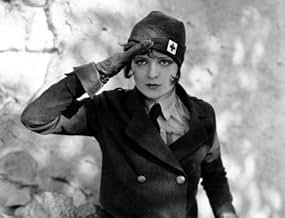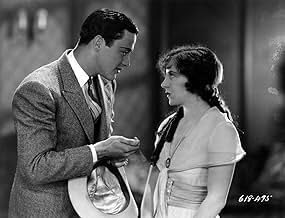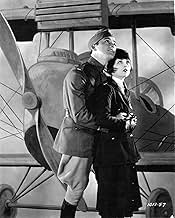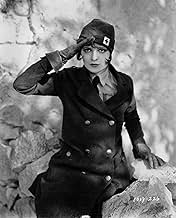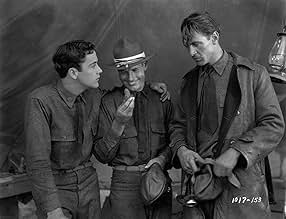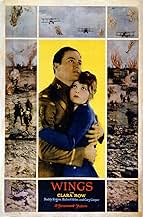IMDb रेटिंग
7.5/10
16 हज़ार
आपकी रेटिंग
अपनी भाषा में प्लॉट जोड़ेंTwo young men, one rich, one middle class, who are in love with the same woman, become fighter pilots in World War I.Two young men, one rich, one middle class, who are in love with the same woman, become fighter pilots in World War I.Two young men, one rich, one middle class, who are in love with the same woman, become fighter pilots in World War I.
- 2 ऑस्कर जीते
- 9 जीत और कुल 1 नामांकन
Charles 'Buddy' Rogers
- Jack Powell
- (as Charles Rogers)
Charles Barton
- Soldier Flirting with Mary
- (बिना क्रेडिट के)
Thomas Carr
- Aviator
- (बिना क्रेडिट के)
Thomas Carrigan
- Undetermined Role
- (बिना क्रेडिट के)
Margery Chapin
- Peasant Woman
- (बिना क्रेडिट के)
Andy Clark
- Undetermined Role
- (बिना क्रेडिट के)
फ़ीचर्ड समीक्षाएं
My cousin Clifford M. Blackstone Sr. was the person who filmed the flight scenes in this movie. His son Cliff sent me photographs of his Dad filming this movie as well as a few others with Paramount Studios. Cliff said his Dad was put in an airplane and sent up in the air to crank out all those amazing flight scenes. He said his Dad told him he wasn't even secured in the plane. Cliff Blackstone Sr. is from Mercer County, PA and Cliff Jr. says his Dad was the man who created the zoom lens. Just a side bar, Clara Bow, the lead actress in Wings, had a hairdresser Maryl who Clara introduced to Cliff Sr. Cliff Sr. married Maryl and they had Cliff Jr. It is really a nice story.
This entertaining and occasionally impressive movie is still well worth seeing in spite of its flaws. The combat scenes alone make the rest of it worth watching, and Clara Bow gives a very good performance. She has plenty of energy as always, and here she makes her character especially sympathetic. But it has its weaknesses, too. The story is contrived and full of obvious holes, and except for Bow most of the acting is rather routine (Buddy Rogers is as likable as ever, but no more).
The highlights of "Wings" come in the battle scenes, and they are awfully impressive. Done without computers or other such advantages, they are exciting and are usually completely realistic. The aerial dogfight scenes are especially dazzling. This part of the movie is not shallow stuff, either, since it has a good balance between the thrilling and the horrifying. If the main story-line had been better, this could have worked very well as a classic film about the realities of war and its effects on the young persons who must carry the heaviest load in a war.
But unfortunately, it has the story that it has, which could easily have been better. It is far too heavy-handed, and is also riddled with unlikely coincidences, implausible developments, strange decisions by the characters, and many other such holes. If you can somehow look past all these problems, then it produces some moving and emotional moments, but such moments are too often undone by the contrived ways that they are set up. It's just the kind of mess that has often impressed the individuals who vote for well-known awards, but a movie with such strengths deserved to have a much better plot.
Nevertheless, it is still well worth watching for its strengths, and not just because it is the answer to some trivia questions. Just in case there are any modern movie fans who have accidentally wandered into the silents section of the database, please don't think that this is the best of what silent cinema has to offer, just because it won an arbitrary award. There are many silent film masterpieces that are vastly better than this. But it's good entertainment, and has some portions that were made with great skill.
The highlights of "Wings" come in the battle scenes, and they are awfully impressive. Done without computers or other such advantages, they are exciting and are usually completely realistic. The aerial dogfight scenes are especially dazzling. This part of the movie is not shallow stuff, either, since it has a good balance between the thrilling and the horrifying. If the main story-line had been better, this could have worked very well as a classic film about the realities of war and its effects on the young persons who must carry the heaviest load in a war.
But unfortunately, it has the story that it has, which could easily have been better. It is far too heavy-handed, and is also riddled with unlikely coincidences, implausible developments, strange decisions by the characters, and many other such holes. If you can somehow look past all these problems, then it produces some moving and emotional moments, but such moments are too often undone by the contrived ways that they are set up. It's just the kind of mess that has often impressed the individuals who vote for well-known awards, but a movie with such strengths deserved to have a much better plot.
Nevertheless, it is still well worth watching for its strengths, and not just because it is the answer to some trivia questions. Just in case there are any modern movie fans who have accidentally wandered into the silents section of the database, please don't think that this is the best of what silent cinema has to offer, just because it won an arbitrary award. There are many silent film masterpieces that are vastly better than this. But it's good entertainment, and has some portions that were made with great skill.
Famous of course for winning the first Oscar for best film, WINGS is also one hell of a good film. Spectacular aerial photography highlights the terrific performances of the three leads: Clara Bow, Buddy Rogers, and Richard Arlen. Director William Wellman creates a solid and moving anti-war statement as he shows us the brutality and stupidity of war, its waste of youth, and its power to destroy the lives of all involved.
The film starts with star-crossed lovers in a small town in America. Bow loves Rogers but he loves Jobyna Ralston. Ralston loves Arlen and he loves her but through a mistake, Arlen thinks she loves Rogers. Then the boys go off to war. The outgoing Rogers thinks the war will be an adventure; the shy Arlen goes off, leaving his devastated parents who cannot express their emotions. Bow soon goes off to be an ambulance driver. Ralston stays homes and waits.
The story follows the rivalry and growing friendship of the boys as they head for war. The story ends in yet another bitter mistake. The viewer is as emotionally drained by the end of this film as the parents were at the beginning.
El Brendel provides some comedy relief. Roscoe Karns has a small part. Henry B. Walthall and Julia Swayne Gordon are the parents. And Gary Cooper has one brief scene with Rogers and Arlen. The scene in which he turns and flashes that famous smile as he exits the tent supposedly made him a star.
Clara Bow is solid as the spirited home-town girl who chases Rogers to no avail. She's gorgeous here and she is even moreso in the Paris scene where the matron lets her borrow a snappy and dazzling dress. Few women in film history have been able to be so sexually charismatic as Clara Bow. She's also a good actress.
Richard Arlen and Buddy Rogers give their best performances here. Each takes turns as the center of attention as they become men during the grueling war. Their flight scenes are incredibly well done. Arlen's flight scene as he races toward the American lines is amazing.
Jobyna Ralston has a rare memorable film not working with Harold Lloyd. And Henry B. Walthall is quietly grand as the crippled father.
Wellman's direction and the camera work of Harry Perry are beyond perfection. The aerial battles are breathtaking as are the scenes where they blow up the German blimps. There's also one astounding scene in the beginning of the film where Ralston and Arlen are in a swing. The camera is mounted in a stationary position in front of the actors so we see the scene as though we are in the swing with them. Then suddenly in the background we see Rogers in his jalopy pulling up in the street. The swing stops and Ralston gets out and runs to Rogers (in the background) while we see the close-up of Arlen as he twists in the swing seat and turns to watch them. It's an amazing scene and all one shot.
This film is a must see.
The film starts with star-crossed lovers in a small town in America. Bow loves Rogers but he loves Jobyna Ralston. Ralston loves Arlen and he loves her but through a mistake, Arlen thinks she loves Rogers. Then the boys go off to war. The outgoing Rogers thinks the war will be an adventure; the shy Arlen goes off, leaving his devastated parents who cannot express their emotions. Bow soon goes off to be an ambulance driver. Ralston stays homes and waits.
The story follows the rivalry and growing friendship of the boys as they head for war. The story ends in yet another bitter mistake. The viewer is as emotionally drained by the end of this film as the parents were at the beginning.
El Brendel provides some comedy relief. Roscoe Karns has a small part. Henry B. Walthall and Julia Swayne Gordon are the parents. And Gary Cooper has one brief scene with Rogers and Arlen. The scene in which he turns and flashes that famous smile as he exits the tent supposedly made him a star.
Clara Bow is solid as the spirited home-town girl who chases Rogers to no avail. She's gorgeous here and she is even moreso in the Paris scene where the matron lets her borrow a snappy and dazzling dress. Few women in film history have been able to be so sexually charismatic as Clara Bow. She's also a good actress.
Richard Arlen and Buddy Rogers give their best performances here. Each takes turns as the center of attention as they become men during the grueling war. Their flight scenes are incredibly well done. Arlen's flight scene as he races toward the American lines is amazing.
Jobyna Ralston has a rare memorable film not working with Harold Lloyd. And Henry B. Walthall is quietly grand as the crippled father.
Wellman's direction and the camera work of Harry Perry are beyond perfection. The aerial battles are breathtaking as are the scenes where they blow up the German blimps. There's also one astounding scene in the beginning of the film where Ralston and Arlen are in a swing. The camera is mounted in a stationary position in front of the actors so we see the scene as though we are in the swing with them. Then suddenly in the background we see Rogers in his jalopy pulling up in the street. The swing stops and Ralston gets out and runs to Rogers (in the background) while we see the close-up of Arlen as he twists in the swing seat and turns to watch them. It's an amazing scene and all one shot.
This film is a must see.
For a feeling of what the silents were really like, look for the version of this film with Gaylord Carter performing the score on a Wurlitzer Theater Organ. Carter recorded this version in the 1980's when he was in his 80's. Amazing performance - basically 120 minutes of live, somewhat improvised music with establihed themes for each character. Incidental music was improvised live combining themes from the various characters.
Carter was one of the last musicians that performed during the silent era. Very few musicians understand how difficult this art form was, and Gaylor was one of the best. Each showing of the film was an original, never before heard version due to the improvisational nature of the music. The stamina required to play live music, on 3, 4 or even 5 keyboards with a pedal board and dozens of stops, thousands of pipes for over two hours cannot be overstated. Especially when one of these performers were expected to do so 3 or more times a day!
Orchestras are all well and good, but few theaters could afford them - Wurlitzer (and a few other companies) sold 40,000 instruments to theaters world wide during the 20's, and chances are, 90% of screenings of this film were accompanied by a theater organ.
Carter was one of the last musicians that performed during the silent era. Very few musicians understand how difficult this art form was, and Gaylor was one of the best. Each showing of the film was an original, never before heard version due to the improvisational nature of the music. The stamina required to play live music, on 3, 4 or even 5 keyboards with a pedal board and dozens of stops, thousands of pipes for over two hours cannot be overstated. Especially when one of these performers were expected to do so 3 or more times a day!
Orchestras are all well and good, but few theaters could afford them - Wurlitzer (and a few other companies) sold 40,000 instruments to theaters world wide during the 20's, and chances are, 90% of screenings of this film were accompanied by a theater organ.
This film is, no doubt, a timeless triumph of the silent cinema. I first saw it three years ago and have seen it at least 30 times since then. I've only looked back to see that I have it in my collection...but not on DVD! These studios need to start thinking back to the days in which movies as good as these were made and stop producing so much garbage that they think will make tons of money without considering whether it's done right or not. This film taught me just how important gesture and body language can be in the acting world, whether it be on film or on stage. I know just how "in-character" an actor is just by looking at their face, their eyes, and how they're written in the script. Don't get me wrong, people can overact and underact in certain parts, but if you do anything without considering your character's expression or mood, regardless of whether or not your voice is unbearable to hear, you will never see success past the sound of crickets hiding in the audience. The industry knew that sound was coming. Most didn't accept this truth, but they knew it alright! "Wings" reminds those who've seen it, as with most classics of the silent cinema, that ACTIONS SPEAK A MUCH GREATER VOLUME THAN THE SPOKEN WORD. I've said all I need to say, and now I'll let this picture speak for itself.
Oscars Best Picture Winners, Ranked
Oscars Best Picture Winners, Ranked
See the complete list of Oscars Best Picture winners, ranked by IMDb ratings.
क्या आपको पता है
- ट्रिवियाWas lost for decades until a copy was discovered languishing in the Cinematheque Francaise film archive in Paris, France.
- गूफ़The film is set during the years 1917-1918, but most of the female civilian clothes and hairstyles are contemporary with the late 1920s, particularly the clothes worn by Clara Bow in the home sequences and in the Folies Bergère sequence. Bow and almost all the other female characters have bobbed hair, common in 1927 but almost non-existent during World War One.
- भाव
Sergeant in Mervale: Hey, if youse guys need kissin' *I'll* kiss you - wit' a gun-butt!
- इसके अलावा अन्य वर्जनSome showings have trimmed Clara Bow's brief topless scene.
- कनेक्शनEdited into The Eagle and the Hawk (1933)
- साउंडट्रैकThe Star Spangled Banner
(credited on 2012 restored score only)
Written by John Stafford Smith & Francis Scott Key
टॉप पसंद
रेटिंग देने के लिए साइन-इन करें और वैयक्तिकृत सुझावों के लिए वॉचलिस्ट करें
- How long is Wings?Alexa द्वारा संचालित
विवरण
बॉक्स ऑफ़िस
- बजट
- $20,00,000(अनुमानित)
- दुनिया भर में सकल
- $1,684
- चलने की अवधि2 घंटे 24 मिनट
- रंग
- ध्वनि मिश्रण
- पक्ष अनुपात
- 1.33 : 1
इस पेज में योगदान दें
किसी बदलाव का सुझाव दें या अनुपलब्ध कॉन्टेंट जोड़ें







